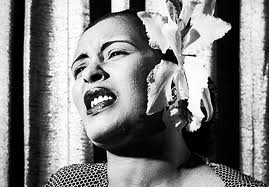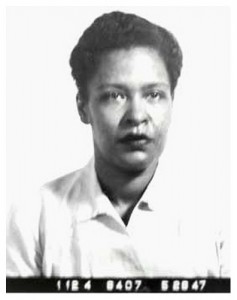Billie Holiday in Conflict With the Law
 Today is Billie Holiday’s birthday and I am currently working on a project about her. I hope to be done with it by the end of this year.
Today is Billie Holiday’s birthday and I am currently working on a project about her. I hope to be done with it by the end of this year.
I have always been interested in Lady Day. It began with watching Diana Ross in Lady Sings the Blues when I was probably around 11 years old.
At the time, I think that I was mostly just fascinated by Diana Ross: her beauty, elegance, and those amazing clothes. I hadn’t seen a black woman like her on television before. Anyway, it turned out that my parents had records by Billie Holiday and I began to listen to them religiously. I don’t know why I found her voice so compelling. I had definitely not lived the type of harrowing childhood that she had. We had nothing in common except for our femaleness and our blackness.
 The story of Lady Day is familiar to many. Eleanora Harris Fagan was 9 years old when she first came into conflict with the law. She was brought before the juvenile court for being truant and for “being without proper care and guardianship.” She was committed for a year at the House of Good Shepherd for Colored Girls, a Catholic reform school. Incidentally, I am currently doing some research on this reform school and will have more to share about it soon.
The story of Lady Day is familiar to many. Eleanora Harris Fagan was 9 years old when she first came into conflict with the law. She was brought before the juvenile court for being truant and for “being without proper care and guardianship.” She was committed for a year at the House of Good Shepherd for Colored Girls, a Catholic reform school. Incidentally, I am currently doing some research on this reform school and will have more to share about it soon.
She was released on parole in October 1925. She was then raped by a neighbor at 11 years old and returned to House of Good Shepherd under “protective custody” as a “state witness” in December 1926. A couple of months later she was released from the reform school after a lawyer intervened by using the grounds of habeas corpus.
In May 1929, Billie is arrested along with her mother and several other women during a night raid of a brothel in Harlem run by a woman named Florence Williams. She is tried and found guilty of vagrancy by a judge named Jean Hortense Norris (who was well-known for giving very harsh sentences to young offenders). She is 14 years old and sent to Welfare Island (now called Roosevelt Island) first and then to a workhouse.
In May 1947, Billie Holiday was arrested for narcotics use in her apartment in New York City. She was tried, pled guilty, and was sentenced to serve time at the Alderson Federal Prison Camp. She was released from prison for good behavior in March 1948. However, Lady Day would continue to be persecuted by law enforcement and others after her release. She gave an interview to Ebony Magazine in 1949 and spoke of this:
“I came out expecting to be allowed to go to work and to start with a clean state…But the police have been particularly vindictive, hounding, heckling and harassing me beyond endurance…These people have dogged my footsteps from New York to San Francisco…They have allowed me no peace. Wherever I go, they track me down and ask me nasty questions about the company I keep and my habits…
Recently the New York Police Department refused to issue me a Cabaret Performer’s Licence. The pretext used was my prison record…although many other nightclub employees with police records are licensed and working.
I have been caught in the crossfire of narcotic agents and drug peddlers and it’s been wicked…One of the narcotic agents seemed determined to make me the means of securing promotion. The peddlers made vile threats to me in an effort to make me a customer again.
Source: With Billie – A New Look At the Unforgettable Lady Day by Julia Blackburn (p.198).
I have been reading Billie Holiday’s FBI file for the past few weeks. It underscores that there was a “war on drugs” against people of color for decades before it was officially declared by Richard Nixon in 1971. It has been eye-opening and reinforces my belief that state violence against people of color is and has always been destructive. Julia Blackburn (2005) writes about her persecution at the hands of the state: “It is true that after her release from prison, Billie was constantly being brought before the courts of law on one pretext or another, and several people who worked with her attested to the fact that the police and other government agents were always at her shows — heckling, threatening, raiding her dressing room, making embarrassing enquiries at her hotel and spreading rumors at the clubs where she was booked to sing (p.199).”
I look forward to sharing the fruits of my Billie Holiday project with all of you in 2013. In the meantime, Happy Birthday Lady Day!
